V1432 Aql time keeping
Observed: 28 June, 22 July, 6, 30 August 2008
Michel Bonnardeau
2 Sept 2008
Revised 19 Feb 2012 (new comparison star and photometry)
Abstract
Light curves for this asynchronous polar are presented. They show the eclipses and the spin modulation. They are compared with ephemerides.
Introduction
V1432 Aql is a cataclysmic system, that is a binary with an accreting white dwarf. It shows eclipses and the orbital period is Porb=3.37h. It is a bright X-ray source and the white dwarf is strongly magnetized.
According to Mukai et al (2003), the white dwarf spin period is almost equal to the orbital period (an asynchronous polar). The spin period is slightly larger than the orbital period, and decreasing with dPspin/dt=-10^-8, so the two periods should equalize in a century.
I already observed this system in 2007.
A CBA target in 2008.
Observations
The observations were carried out with the same setup as in 2007:
An example of a light curve:
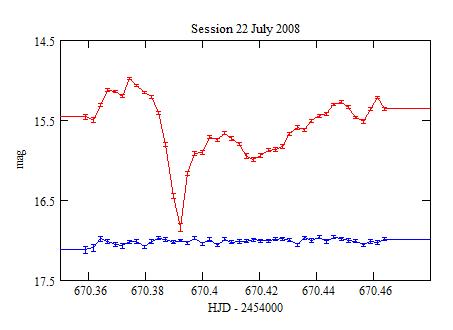
Red: V1432 Aql, Blue: the check star. The error bars are +/- the 1
sigma statistical uncertainties.
Comparison with the orbital ephemeris
According to Mukai et al (2003), an ephemeris for the orbital motion
is:
t(E) = To + Po*E
with To = 2,449,199.693 HJD
Po = 0.14023475 d
My data are in good agreement with this ephemeris:
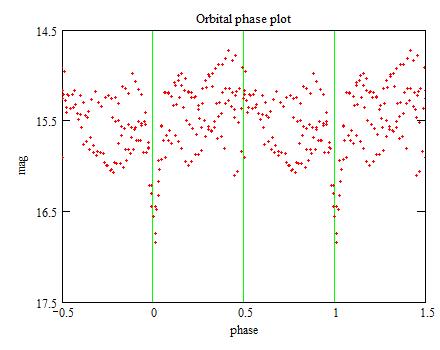
Another ephemeris from Andronov et al (2006) is:
To = 2,451,492.09876 HJD
Po = 0.140235812 d
This is not compatible with Mukai et al (2003) and this gives a shift
with my data.
Comparison with the spin ephemeris
Andronov et al (2006) gives the ephemeris for the spin modulation (the
minimum):
t(E) = Ts + Ps*E +b*E^2
with Ts = 2,449,638.327427 HJD
Ps = 0.14062831 d
b = -7.81*10^-10
My data are in good agreement with this ephemeris:
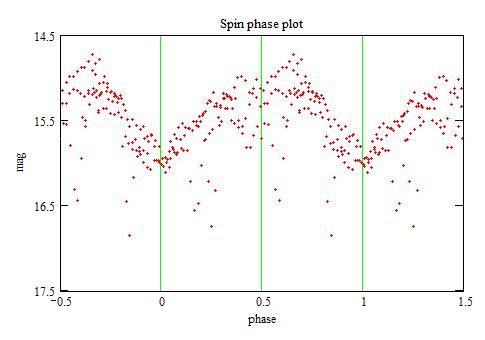
Mukai et (2003) also gives an ephemeris, with a lesser spin up (b=-6.5*10^-10) , and my observations do not fit it.
The spin minimum I observe is then at:
Ts8 =2,454,679.1297 HJD
and in 2007 I observed it at:
Ts7 = 2,454,313.629 HJD
The O-C diagram of my minima versus the Andronos et al (2006)'s ephemeris,
along with the minima of Mukai et al (2003) is:
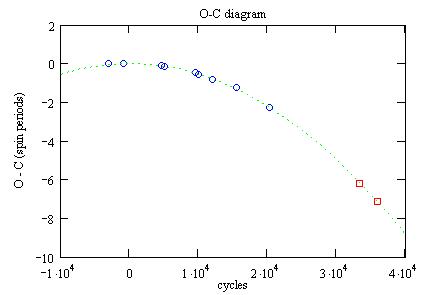
Red squares: my 2007 and 2008 observations, Blue circles: Mukai et
al (2003)'s observations, Green dots: Andronov et al (2006)'s ephemeris.
Modelling
The orbital modulation may be described with the function:

with Aorb = 15.8
and Borb = 1
and the spin modulation with:

with Aspin =15.05
and Bspin = 0.6.
The observed light curves with the modelling functions are:

Red: V1432 Aql, Brown: the Horb modelling function, Blue: the Hspin
function.

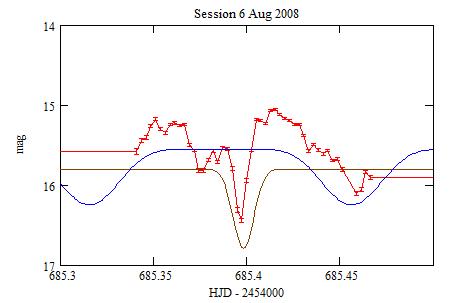
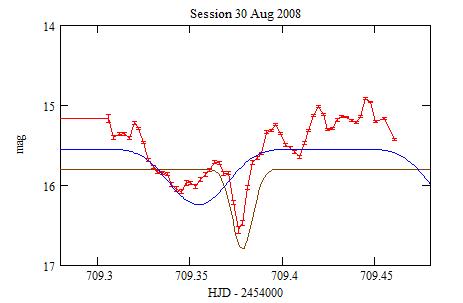
References
Andronov I.L., Baklanolv A.V., Burwitz V. (2006) A&A 452 941.
Mukai K., Hellier C., Madejski G., Patterson J., Skillman D.R. (2003) ApJ 597 493.
Technical notes
Telescope and camera configuration.
Computer and software configuration.
|
|
|||
|
|||
|
|
|||
|
|
|||
|
|||
